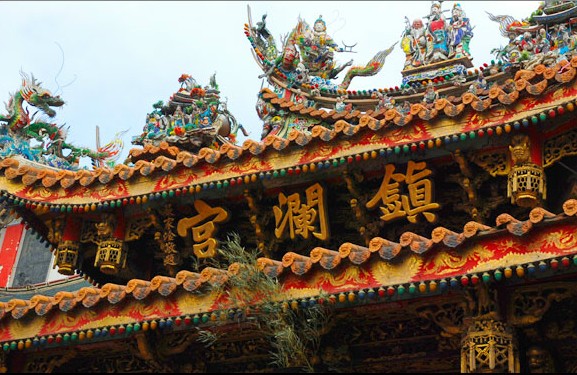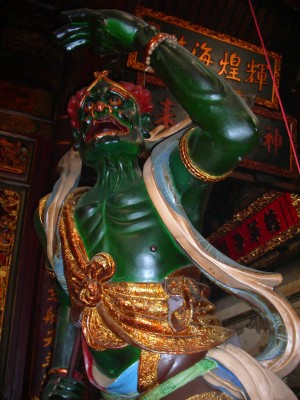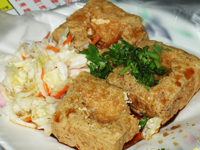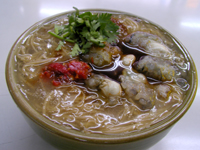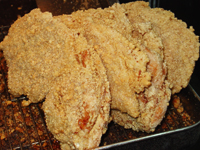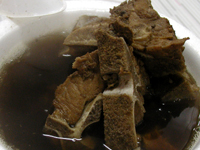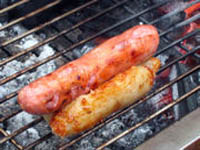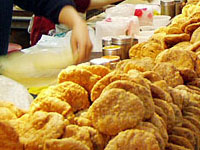| ||
| Mazu (s-Chinese: 妈祖; t-Chinese: 媽祖; pinyin: Māzǔ; Wade-Giles: Ma-tsu;literally "Mother-Ancestor"), also spelt Matsu, is the indigenous goddess of the sea who protects fishermen and sailors, and is invoked as the goddess who protects East Asians who are associated with the ocean. Her mortal name is Lin Moniang (s-Chinese: 林默娘; t-Chinese: 林默娘; pinyin: Lín Mòniáng). She is widely worshipped in the south-eastern coastal areas of China and neighbouring areas in Southeast Asia, especially Zhejiang, Fujian, Taiwan, Guangdong, and Vietnam, all of which have strong sea-faring traditions, as well as migrant communities elsewhere with sizeable populations from these areas. | ||
Popular names
| ||
Official titles
| ||
PersonAccording to legend, Lin Moniang was born in 960 AD (during the early Northern Song Dynasty) as the seventh daughter of Lin Yuan (林愿) on Meizhou Island, Fujian. She did not cry when she was born, and thus her given name means "Silent Girl." There are many legends about her and the sea. Although she started swimming relatively late at the age of 15, she soon became an excellent swimmer. She wore red garments while standing on the shore to guide fishing boats home, even in the most dangerous and harsh weather. According to legend, Lin Moniang's father and brothers were fishermen. One day, a terrible typhoon arose while they were out at sea, and the rest of her family feared that those at sea had perished. In the midst of this storm, depending on the version of the legend, she fell into a trance while praying for the lives of her father and brothers or dreamed of her father and brothers while she was sleeping or sitting at a loom weaving. In either story, her father and brother were drowning. However, Moniang's mother now discovered her and tried to wake her, and diverted Moniang's attention, causing her to drop her brother, who as a result drowned. Consequently, Moniang's father returned alive and told the other villagers that a miracle had happened. Other versions of the story relate four drowning brothers, with three returning and the fourth lost to her being revived (with no mention of a father). Mazu is usually depicted together with two guardian generals known as "Thousand Miles Eye" (千里眼, Qianli Yan) and "With-the-Wind Ear" (順風耳 Shunfeng Er). Their iconography, apart from resembling fierce demons can vary but "Thousand Miles Eye" is often red in color with two horns, while "With-the-Wind Ear" is green with one horn. They are said to have been two demons whom Mazu conquered and subdued, turning them into her own loyal guardians and friends. | ||
| ||
| Mazu herself is usually depicted wearing a red robe in paintings or murals, but in sculpture is always clothed in the jewel-festooned robes of an empress holding either a ceremonial tablet or a jewel staff, and wearing the easily recognized flat-topped imperial cap with hanging beads front and back. The tomb of Mazu in Matsu VillageThere are at least two versions of Lin Moniang's death. In one version, she died in 987 at the age of 28, when she climbed a mountain alone and flew to heaven and became a goddess. Another version of the legend says that she died at age 16 of exhaustion after swimming far into the ocean trying to find her lost father and that her corpse later washed ashore on Nankan Island of the Matsu Islands.Buddhism and Taoism borrowed popular deities from each other in attempts to attract devotees to their temples. In an attempt to justify Mazu's presence in Buddhist temples, legends were circulated claiming that Mazu's parents prayed to Guan Yin for a son, but Guanyin answered their prayers with the birth of yet another daughter. It was then believed that Mazu was a reincarnation of Guanyin on earth, and it is Guanyin she is said to have been especially devoted to as a child. As a result, Mazu is recognized and respected in both the Taoist and Buddhist pantheons of deities, while some Buddhists believe Mazu to be one of Guanyin's many manifestations. |
2009年11月24日 星期二
Da-Jia Ma-Zu 大甲 媽祖
2009年11月19日 星期四
My favorite movie list _4
France:
Chinese:
Japan:
Thailand:
- Choristes, Les
- Butterfly , The
Chinese:
- 齊天大聖東遊記 A Chinese Odyssey Part One: Pandora's Box
- 新難兄難弟 He Ain't Heavy, He's My Father!
- 無間道 Infernal Affairs
- 霍元甲 Fearless
- 大隻佬 Running On Karma
Japan:
- 忍 Shinobi
- 咒怨 Ju-on
- リング 7nights
Thailand:
- 鬼影 Shutter
My favorite movie list _3
- Pianist , The
- Predator
- Reign over me
- Saving Private Ryan
- Shall We Dance
- Shawshank Redemption , The
- Skeleton Key , The
- Stardust
- Superman Returns
- Swordfish
- Terminator
- The Fifth Element












- The Prestige
- The Sixth Sense
- The Terminal
- Titanic
- Truman Show , The
- Van Helsing
- War of the Worlds
- Wild Hogs
- Yes Man









My favorite movie list _2
ENGLISH
- Green Mile
- Groundhog Day
- Hancock
- Hot Fuzz
- I , Robot
- Iron Man
- Jurassic Park
- Let's Go to Prison
- Lord of War
- Lucky Number Slevin
- Matrix series
- Minority Report
- Mission to Mars
- Moulin Rouge
- Nacho Libre
- Next
- Paycheck
- Perfume, The


















2009年11月18日 星期三
Riligions In Taiwan
Government figures
The table shows official statistics on religion issued by the Department of Civil Affairs, Ministry of the Interior ("MOI"), in 2005. The ROC government recognizes 26 religions in Taiwan. The statistics are reported by the various religious organizations to the MOI:
(*I have even never heart some of them..... ^^")
| Religion | Members | % of total population | Temples & churches |
| Buddhism ( 佛教 ) (including Tantric Buddhism ) | 8,086,000 | 35.1% | 4,006 |
| Taoism ( 道教 ) | 7,600,000 | 33.0% | 18,274 |
| I-Kuan Tao ( 一貫道 ) | 810,000 | 3.5% | 3,260 |
| Protestantism ( 基督新教 ) | 605,000 | 2.6% | 3,609 |
| Roman Catholic ( 羅馬天主教 ) | 298,000 | 1.3% | 1,151 |
| Lord of Universe Church ( 天帝教 ) | 298,000 | 1.3% | 50 |
| Maitreya Great Tao ( 彌勒大道 ) | 250,000 | 1.1% | 2,200 |
| Tian De Jiao ( 天德教 ) | 200,000 | 0.9% | 14 |
| Liism ( 理教 ) | 186,000 | 0.8% | 138 |
| Syuan Yuan Jiao ( 軒轅教 ) | 152,700 | 0.7% | 22 |
| Islam ( 伊斯蘭教 ) | 58,000 +88,500 Indonesians | 0.3% | 6 |
| The Church of Jesus Christ of Latter-day Saints ( 耶穌基督後期聖徒教會 ) | 47,000 | 0.2% | 54 |
| Tenrikyo ( 天理教 ) | 35,000 | 0.2% | 153 |
| Universe Mealler Faith ( 宇宙彌勒皇教 ) | 35,000 | 0.2% | 12 |
| Hai Tze Tao ( 亥子道 ) | 30,000 | 0.1% | 55 |
| Church of Scientology ( 山達基教會 ) | 20,000 | < 0.1% | 7 |
| Bahá'í Faith ( 巴哈伊教 ) | 16,000 | < 0.1% | 13 |
| Jehovah's Witnesses ( 耶和華見證人 ) | 6,223 | < 0.1% | 85 |
| The Chinese Heritage and Moral Sources ( 玄門真宗 ) | 5,000 | < 0.1% | 5 |
| Zhonghua Sheng Jiao ( 中華聖教 ) | 3,200 | < 0.1% | 7 |
| Mahikari ( 真光教團 ) | 1,000 | < 0.1% | 9 |
| Red Swastika Society ( 先天救教 ) | 1,000 | < 0.1% | 6 |
| Huang Zhong ( 黃中 ) | 1,000 | < 0.1% | 1 |
| Da Yi Jiao ( 大易教 ) | 1,000 | < 0.1% | 1 |
| Total religious population | 18,724,823 | 81.3% | 33,223 |
| Total population | 23,036,087 | 100% - |
(Following part is more transparent)
CIA figures
- Both Buddhist and Taoist: 93%
- Christian: 4.5%
- Other: 2.5%
Buddhism, Taoism, and folk religion
According to the Central Intelligence Agency ( CIA ) of the USA, there are about 93% of people identifying themselves as Buddhists , Taoists , or practitioners of Chinese folk religion . However, as with the majority of East Asian religious traditions in general, identification with these faiths does not necessarily mean actual affiliation as it does in many other parts of globe. It is also common for people to practice a blend of the three religions. Some people practice Buddhism exclusively, but most blend Taoist religious practices with elements from Buddhism and folk traditions. It is not uncommon to find a Buddhist temple adjacent to a Taoist temple, or even under the same roof. One example of this is Longshan Temple in Taipei City . Religious diversity has never been a significant source of conflict in Taiwan.
Besides large temples, small outdoor shrines to local deities are very common, and can be spotted on roadsides, parks, and neighborhoods in Taiwanese cities and towns. These small pockets of religious atmosphere let people stop by and pray informally anytime. They also provide a safe environment for locals to practice meditation and various other forms of religious practice. Many homes and businesses may also set up small shrines of candles, figurines, and offerings. Some restaurants, for example, may set up a small shrine to the Kitchen god for success in a restaurant business. Students may visit a shrine to the Learning god for good luck before a test.
Taoist temples are highly decorative. Colorfully tiled sculptures of dragons and other mythological creatures highlight the roof, and temples are often filled with statues of many gods and semi-theistic historical figures, reflecting the polytheistic and ancestor worship tradition of Taoism and folk religion.
Festivities and picnics often take place at Taoist temples.
There are approximately 4.55 million or 4.5 million Taoists in Taiwan and 4.9 million Buddhists .
Buddhism
Buddhism was introduced to Taiwan in the late 1500s with the Chinese immigration. Several forms of Buddhism have thrived on Taiwan ever since. During the Japanese occupation, Japanese Buddhism ( Shingon , Jodo Shinshu , Nichiren Shu , etc.) was introduced as part of the overall policy of cultural assimilation by the colonial government. Although many Buddhist communities affiliated themselves with Japanese sects for protection, they largely retained Chinese Buddhist practices. For instance, clerical marriage and meat-eating did not make the headway they did in occupied Korea. Today, approximately 94% of Taiwan's population is Buddhist] .
Following retrocession, Taiwan was inundated with Mainland monks, including some who were considered to be of the best and brightest of the previous decades, such as Master Yinshun (Yìnshùn 印順). Tainted by the whiff of collaboration, outshone by these refugees, and underrepresented in the Chinese Buddhist Association (CBA) which served as a liaison with the government, the local lineages declined.
The CBA remained the dominant Buddhist organization until the end of martial law, when its government mandated monopoly was ended. Since the eighties, Buddhism has enjoyed a surge of popularity as the percentage of people identifying themselves as Buddhist rose from the low teens to almost fifty percent. Today there are several large Buddhist organization based in Taiwan that have expanded to become international organization. They include Dharma Drum Mountain (Făgŭshān 法鼓山 ) founded by late Master Sheng Yen ( 聖嚴 ), Buddha's Light International (Fógŭangshān 佛光山 ) founded by Master Hsing Yun ( 星雲 ), and the Tzu Chi Foundation (Cíjì jījīnhùi 慈濟基金會 ) founded by Master Cheng Yen ( 證嚴法師 ).
Tzu Chi , one of the largest international non-profit Buddhist organizations, focuses on community service, outreach programs, charity work, and international humanitarian efforts. They have opened hospitals, community centers, schools, and Tzu Chi University in Hualien County .
In the last few years non-Chinese forms of Buddhism, such as Tibetan Buddhism , the Soka Gakkai International and the Vipassana movement of S. N. Goenka , have also had growing followings...
Christianity
Christian churches exist on the Republic of China ( Taiwan ). According to figures given by the Central Intelligence Agency ( CIA ), Christians which include Protestants , Catholics , Mormons , and non-denominational Christians make up a total of 4.5% of the population of Taiwan.
Islam
Though Islam originated in the Arabian Peninsula , it had spread eastward to China as early as the 7th century AD. Muslim merchants married local Chinese women, creating a new Chinese ethnic group called the Hui people . Islam first reached Taiwan in the 17th century when Muslim families from the southern Chinese coastal province of Fujian accompanied Koxinga on his invasion to oust the Dutch from Taiwan. Islam did not spread and their descendants became assimilated into the local Taiwanese society adopting the local customs and religions.
During the Chinese Civil War , some 20,000 Muslims, mostly soldiers and civil servants, fled mainland China with the Kuomintang to Taiwan. Since the 1980s, thousands of Muslims from Myanmar and Thailand, who are descendants of Nationalist soldiers who fled Yunnan as a result of the communist takeover, have migrated to Taiwan in search of a better life. In more recent years, there has been a rise in Indonesian workers to Taiwan. There are an estimated 88,000 Indonesian Muslims living in Taiwan [ 12 ] , in addition to the existing 53,000 Taiwanese Muslims. All demographics combined, there are over 140,000 Muslims in Taiwan.
Falun Gong 法輪功
Even though Falun Gong is banned in China , people in Taiwan are free to practice it.
2009年11月17日 星期二
Common Taiwan Snacks
These are some common Taiwan Snacks, you can find them easily in most night markets.
Oyster-filled Omelet蚵仔煎(O-a-chian)NT$~50 | The egg is added putting the mark to the water of flour with the debt by the ke child stir-frying (oyster omelet). The light that puts all of the vegetable etc. at the ke child end, completes, and puts some sauce on further that becomes very delicious. |
Stinky tofu臭豆腐(Chou Dofu)NT$~40 | Stinky tofu is a form of fermented tofu, which, as the name suggests, has a strong odor. It is put that the pan is painted with the fermenting bean curd and Nateki explodes, and knows the smelly tofu that completes the appearance in which pickles afterwards, with acidity with a good mouth hit are superadded and I am seen to be a very delicious. |
Oyster Vermicelli蚵仔麵線(o-a mi-soa)NT$~50 | Street vandors expertly combine handmade vermicelli with a variety of seasoned ingredients, such as slow-cooked pork-tripe and fresh oyster. Its great favor is the use of seep-fried minced shallots. |
Shilin Super Size Huge Chicken Cutlet豪大炸雞排(Ho-Da Ja-Ji-Pai)NT$~50 | Shilin Super Size Huge Chicken Cutlet is one of the most popular street foods in Taiwan. However, this snack at Shilin Night Market is famous for its jumbo size. It is 1.5 times larger than regular friend chicken; perhaps larger than your face. Taiwanese fried chicken is soaked in special sauce before frying, and its taste is mixed with spicy pepper and aromatic herbals, and the meat quality is tender and juicy; it is of its own kind other from common western style fried chicken. |
Bubble Tea珍珠奶茶NT$~30 | Pearl milk Tea originated from Taichung, Taiwan. It is a special beverage in Taiwan. The famous tea drink is made from little tapioca balls that are boiled in black sugar and dropped in the milk tea, which tastes great served cold or hot. |
Wok-fried Squid生炒花枝(Sheng Chao Hua Zhi)NT$~50 | Fresh squid is sliced and then wok-fried with garlic, red pepper, bamboo shoot slices, and carrots, and boiled with stock soup to make thick soup. Tasted somewhat sour with sweetness and aroma of basil; it opens up appetite. Squid itself has no distinct flavor, but the crisp chewing makes it one of the most popular seafood among Taiwanese people. |
Health spareribs soup with Chinese medicine藥燉排骨(Yao Dun Pai Gu)NT$~90 | Taiwanese like to maintain health with health enhancing diets, and the herbal stew of ribs is the most classic and affordable nutrient gourmet dish. Its stock soup includes more than ten varieties of Chinese herbal medicines that are stewed for 3 to 4 hours before used for boiling fresh pork ribs. Its dark appearance may look deterring, but after pork ribs are boiled to soft with flavors are brought out, the soup tastes light and sweet with unique aromatic scent of herbals. |
Mango Ice芒果冰(Mango-bin)NT$~80 | Mangos are among the tastiest fruits you can enjoy in Taiwan. While just eating the succulent sweet flesh is a great pleasure in itself, the experience becomes even more pleasurable when fresh mango is combined with ice cream or condensed milk atop shaved ice. In recent years mango ice has become extremely popular in Taiwan. |
Fried Buns生煎包(sheng jian bao)NT$~10 | These delicacies come with either a vegetable filling of cabbage and mushrooms or a meat filling of pork and scallions. As the patiently waiting customers like to note, “You haven't been to Shi Lin Night Market if you haven't had Shanghai buns.” But be careful when biting a freshly-cooked bun, lest you get burned by the hot juice inside. |
Sausage Wrappened in Glutinous Rice大腸包小腸(Dacha-po-Xiaocha)NT$~40 | A segment of Taiwanese pork sausage is wrapped in a (slightly bigger and fatter) glutinous rice to make this delicacy, usually served chargrilled. It may be compared to a hot dog. Deluxe versions are available in night markets in Taiwan, with condiments such as pickled bokchoi, garlic, and thick soy sauce paste to complement the taste. |
Bun in a Bun大餅包小餅(Da Bing Bao Xiao Bing)NT$~50 | This snack is recommended by many foreign tourists. Wrapped under handmade flour crust is a crispy, smaller fried cake that comes with optional fillings including bean paste, taro, sesame, curry, and chilly. It tastes totally different from western style desserts, and is one of the most famous key signature snacks. You may find Bun in a Bun stall in the Shilin Night Market. |
Snow Flakes Crushed Ice雪花冰(Xue Hua Bin)NT$~80 | Snow Flake Crushed Ice looks like layers and layers of snow flakes. It is a unique ice block with mixtures of flavors of milk, peanuts, coffee, and others, machine-chopped to beautiful layers of snow flakes; stacked up to more than 3 inches on a plate. |
Source of Data : http://www.nightmarketsintaiwan.com/detail.html
訂閱:
文章 (Atom)
